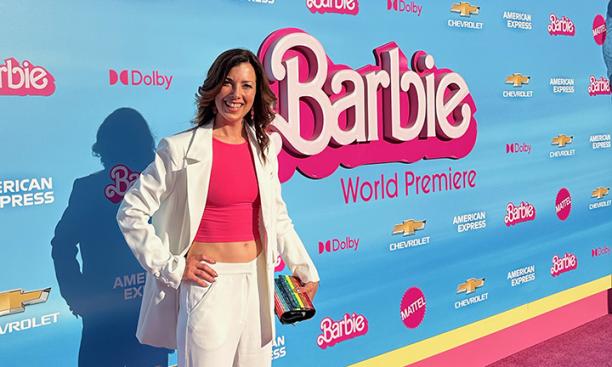
Cate Adams ’08 wasn’t a “Barbie obsessive” growing up, but of course — of course — she played with them. It’s one reason why she was excited to be a part of the summer blockbuster’s production team.
“My older sister had Barbies and I think we made so many Weird Barbies that my mom stopped buying new Barbies for me,” Adams says, referencing a quirky character in the movie played by comedian Kate McKinnon. If you’ve seen Barbie, then you know that Weird Barbie is a far cry from the Stereotypical Barbie (another character) that springs to mind — Adams’ Barbies had haircuts and gum in their hair, and one had burns and disfigured feet from a close encounter with a lamp.
Happy memories were birthed nonetheless, and when Adams heard rumblings of a Barbie deal in the works, she wanted in. That movie, directed by Greta Gerwig and starring Margot Robbie and Ryan Gosling, has now become a cultural phenomenon and passed $1 billion in worldwide ticket sales. “You don’t dream about that — you don’t want to jinx it,” Adams says of the film’s success.
As a senior vice president of production at Warner Bros. Pictures, Adams oversees the creative development and production of the studio’s films. “Basically, we try to help filmmakers’ vision service the broad audience,” she says.
In this case, she was one of the early readers of the script, she helped navigate the studio's relationship with Barbie’s manufacturer, Mattel, she advocated for the filmmakers’ vision, she negotiated for more money in the budget, and she got to watch the film as it was being made and give feedback.
Adams watched the raw, unedited footage that was taken every day, and she visited the London set twice during filming. “It’s the happiest set I’ve ever been on. Like, I’m not kidding,” she says. “Greta, when she was filming it, and Margot too, really set the tone for making sure that everyone was on board for this joyful expression of what the movie was.”
Adams remembers a lot of conversations about the movie’s budget, and the models and projections showing how well it could do at the box office compared to similar films. It had an unusual mix of factors, and runaway success wasn’t a given. “The thing about Barbie is that it wasn’t comparable,” Adams says. Female-driven comedies tend to have a cap at the box office, but Barbie had big movie stars and an appeal to both women and men, she says.
The film also benefited from an “unprecedented” and “overwhelming” marketing push from Warner Bros. and Mattel, as well as a slew of other promotional partners. The blanketing of “Barbiecore” bright pink in advertisements, as well as a layer of mystery regarding what exactly the movie would be about, led people to flock to movie theaters when the film was released.
Ultimately, viewers found a meaningful message lingering behind that bright pink facade (no spoilers here!), and Adams says the response to the movie ended up giving her “hope for humanity.”
“We all are just trying to get by,” she says of the movie’s message. “I think it shows you that it is OK to be messy because life is messy, and if we all have a little bit more empathy for each other in the messiness of just trying to get through it, the world might be a little better.”
Watch the trailer for Barbie:
